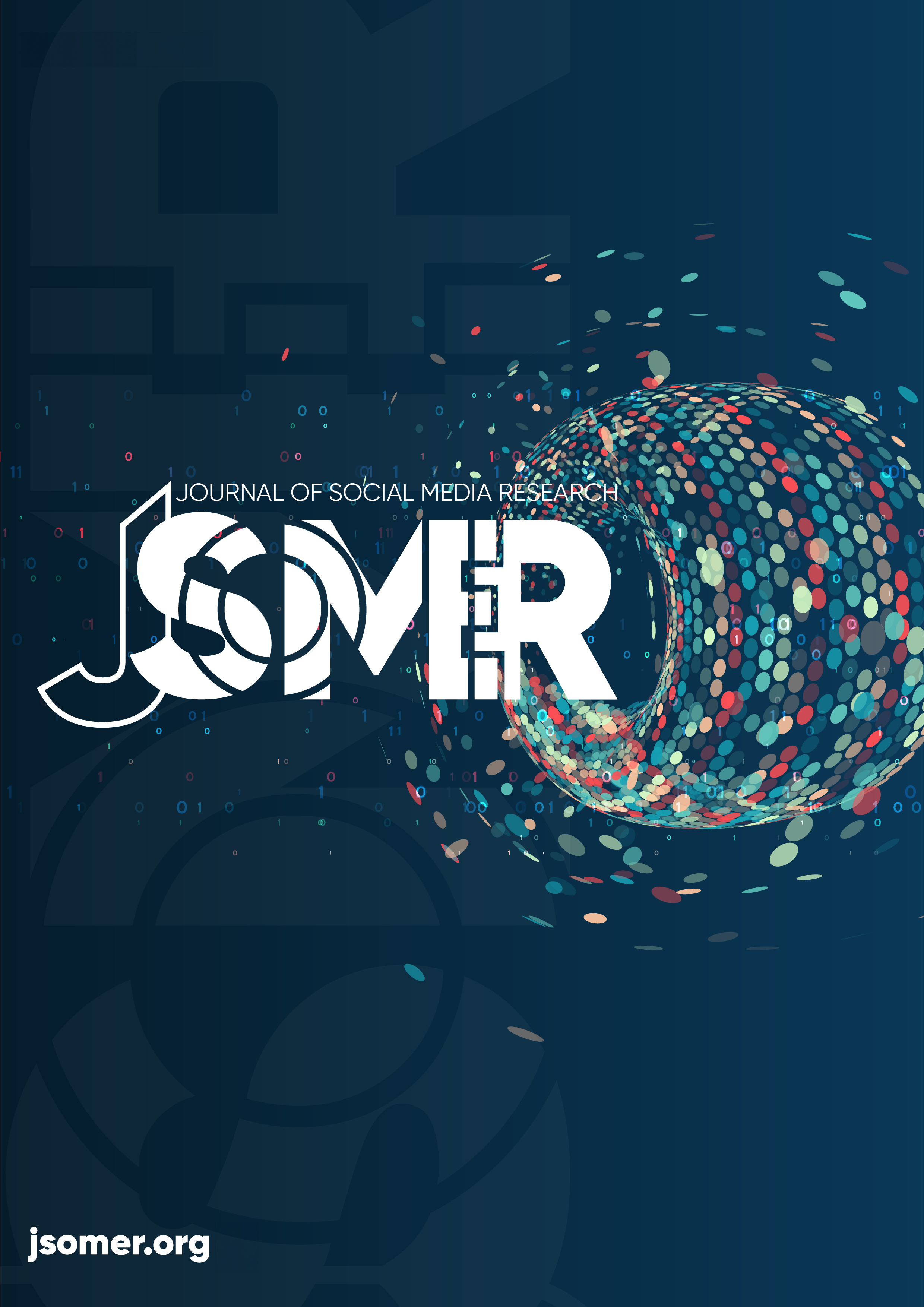Bestseller best Practices: A digital ethnography of #BookTok content on TikTok
DOI:
https://doi.org/10.29329/jsomer.26Keywords:
TikTok, BookTok, Theory of Affordances, Uses and Gratification TheoryAbstract
This research employed a mixed methods digital ethnography to analyze BookTok, the subcommunity about books on TikTok. Grounded in the theory of affordances (Ronzhyn et al., 2022) and Uses and Gratifications Theory (Katz et al., 1973-1974), the study examined the frequencies of varying poster roles, book genres, and content categories in the subcommunity, as well as associations between all of those variables. In doing so, this research added to theoretical understandings about social media while also expanding TikTok research and knowledge about the wider book industry and marketplace. While making similar types of content overall, the findings demonstrated that the authors’ behavior diverged from that of more general users, like readers, as readers are recommending on BookTok more than authors are promoting. This indicates that readers, who are outside of the authors’ control, are an important component of book marketing on BookTok. Posters’ recommendations included memes, comedic content, accessories, etc.
References
Amazon. (2022, February 28). Product details for A Million Kisses in Your Lifetime (Lancaster Prep) by Monica Murphy. https://www.amazon.com/Million-Kisses-Your-Lifetime/dp/B09TMT5W26
Barnes & Noble. (n.d.). BookTok. Barnes & Noble. https://www.barnesandnoble.com/b/booktok/_/N-2vdn
Beditz, M. (2018). The dynamic landscape of marketing children’s books: Publishers find consistent success through a combination of online and traditional marketing to adults and children. Publishing Research Quarterly, 34(2), 157–169. https://doi.org/10.1007/s12109-018-9584-1
DeMarco, N. (2022, August 30). The state of the beach read. Book Riot. https://bookriot.com/history-of-the-beach-read/#:~:text=About%20half%20of%20us%20 read,time%20and%20brain%20space%20available.
Grandinetti, J., & Bruinsma, J. (2022). The affective algorithms of conspiracy TikTok. Journal of Broadcasting & Electronic Media, pp. 1–20. https://doi.org/10.1080/08838151.2022.2140806
Harris, E.A. (2022, July 6). How TikTok became a best-seller machine. The New York Times. https://www.nytimes.com/2022/07/01/books/tiktok-books-booktok.html
Jaramillo-Dent, D., Alencar, A., & Asadchy, Y. (2022). #Migrantes on TikTok: Exploring platformed belongings. International Journal of Communication, 16, 5578–5602. https://ijoc.org/index.php/ijoc/article/view/17435
Jerasa, S., & Boffone, T. (2021). BookTok 101: TikTok, digital literacies, and out‐of‐school reading practices. Journal of Adolescent & Adult Literacy, 65(3), 219–226. https://doi.org/10.1002/jaal.1199
Katz, E., Blumler, J. G., & Gurevitch, M. (1973–1974). Uses and gratifications research. Public Opinion Quarterly, 37(4), 509–523. https://doi.org/10.1086/268109
Kaye, D. B. V., Rodriguez, A., Langton, K., & Wikström, P. (2021). You made this? I made this: Practices of authorship and (mis)attribution on TikTok. International Journal of Communication, 15, 3195–3215. https://ijoc.org/index.php/ijoc/article/view/14544
Laing, A. (2017). Authors using social media: Layers of identity and the online author community. Publishing Research Quarterly, 33(3), 254–267. https://doi.org/10.1007/s12109-017-9524-5
Lo, E. Y. (2020). How social media, movies, and TV shows interacts with young adult literature from 2015 to 2019. Publishing Research Quarterly, 36(4), 611–618. https://doi.org/10.1007/s12109-020-09756-8
Martens, M., Balling, G., & Higgason, K.A. (2022). #BookTokMadeMeReadIt: Young adult reading communities across an international, sociotechnical landscape. Information and Learning Sciences, 123(11–12), 705–722. https://doi.org/10.1108/ILS-07-2022-0086
Meservy, T.O., Fadel, K. J., Nelson, B., & Matthews, M. (2019). Production vs. consumption on social media: A Uses and Gratifications perspective [Conference paper]. Twenty-fifth Americas Conference on Information Systems, Cancun.
Murthy, D. (2008). Digital ethnography: An examination of the use of new technologies for social research. Sociology, 42(5), 837–855. https://doi.org/10.1177/0038038508094565
Nguyen, H.V., Huy, L.V., Nguyen, T.N., Dinh, V.S., & Tran, V.T. (2019). The role of social media in the purchase of books: Empirical evidence from Vietnam’s publishing industry. Publishing Research Quarterly, 35(4), 704–709. https://doi.org/10.1007/s12109-019-09682-4
Peña-Fernández, S., Larrondo-Ureta, A., & Morales-i-Gras, J. (2022). Current affairs on TikTok. Virality and entertainment for digital natives. El Profesional de La Información, 31(1), 1–12. https://doi.org/10.3145/epi.2022.ene.06
Perreau, A. (2021). Brands on TikTok: Strategic first steps and successful execution. Journal of Brand Strategy, 10(3), 221–233. https://www.henrystewartpublications.com/sites/default/files/JBS10.3BrandsonTikTokStrategicfirststepsandsuccessfulexecution.pdf
P.T, A. (2023, October 5). What is the best time to post on TikTok in 2023? SocialPilot. https://www.socialpilot.co/blog/best-time-to-post-on-tiktok
Ronzhyn, A., Cardenal, A.S., & Batlle Rubio, A. (2022). Defining affordances in social media research: A literature review. Social Media + Society, 25(11), 3165–3188. https://doi.org/10.1177/14614448221135187
Schellewald, A. (2021). Communicative forms on TikTok: Perspectives From digital ethnography. International Journal of Communication, 15, 1437–1457. https://ijoc.org/index.php/ijoc/article/view/16414
Seaver, N. (2017). Algorithms as culture: Some tactics for the ethnography of algorithmic systems. Big Data & Society, 4(2), 1–12. https://doi.org/10.1177/2053951717738104
Southerton, C. (2021). Lip-syncing and saving lives: Healthcare workers on TikTok. International Journal of Communication, 15, 3248–3268. https://ijoc.org/index.php/ijoc/article/view/16900/3498
Sternlicht, A. (2023, November 29). The death of TikTok’s $2 billion Creator Fund is stoking fears among influencers about the value of short-form videos on the platform. Fortune. https://fortune.com/2023/11/29/tiktok-killed-creator-fund-influencers-worry-short-form-video/
The Overstory. (2023, July 25). In Wikipedia. https://en.wikipedia.org/wiki/The_Overstory
Vallese, Z. (2023, February 27). In the three-way battle between YouTube, Reels and TikTok, creators aren’t counting on a big payday. CNBC https://www.cnbc.com/2023/02/27/in-youtube-tiktok-reels-battle-creators-dont-expect-a-big-payday.html
Weinberg, D.B., & Kapelner, A. (2022). Do book consumers discriminate against Black, female, or young authors? PLoS ONE, 17(6). e0267537. https://doi.org/10.1371/journal.pone.0267537
Zarroli, J. (2021, December 31). TikTok is driving book sales. Here are some titles #BookTok recommends [Radio broadcast transcript]. NPR. https://www.npr.org/2021/12/26/1068063564/booktok-is-a-new-force-driving-book-sales-and-publishing-deals
Zeng, J., Abidin, C., & Schӓfer, M.S. (2021). Research perspectives on TikTok and its legacy apps: Introduction. International Journal of Communication, 15, 3161–3172. https://ijoc.org/index.php/ijoc/article/view/14539
Additional Files
Published
How to Cite
Issue
Section
License
Copyright (c) 2025 Dominic Rascati, Susan Grantham

This work is licensed under a Creative Commons Attribution-NonCommercial-NoDerivatives 4.0 International License.










